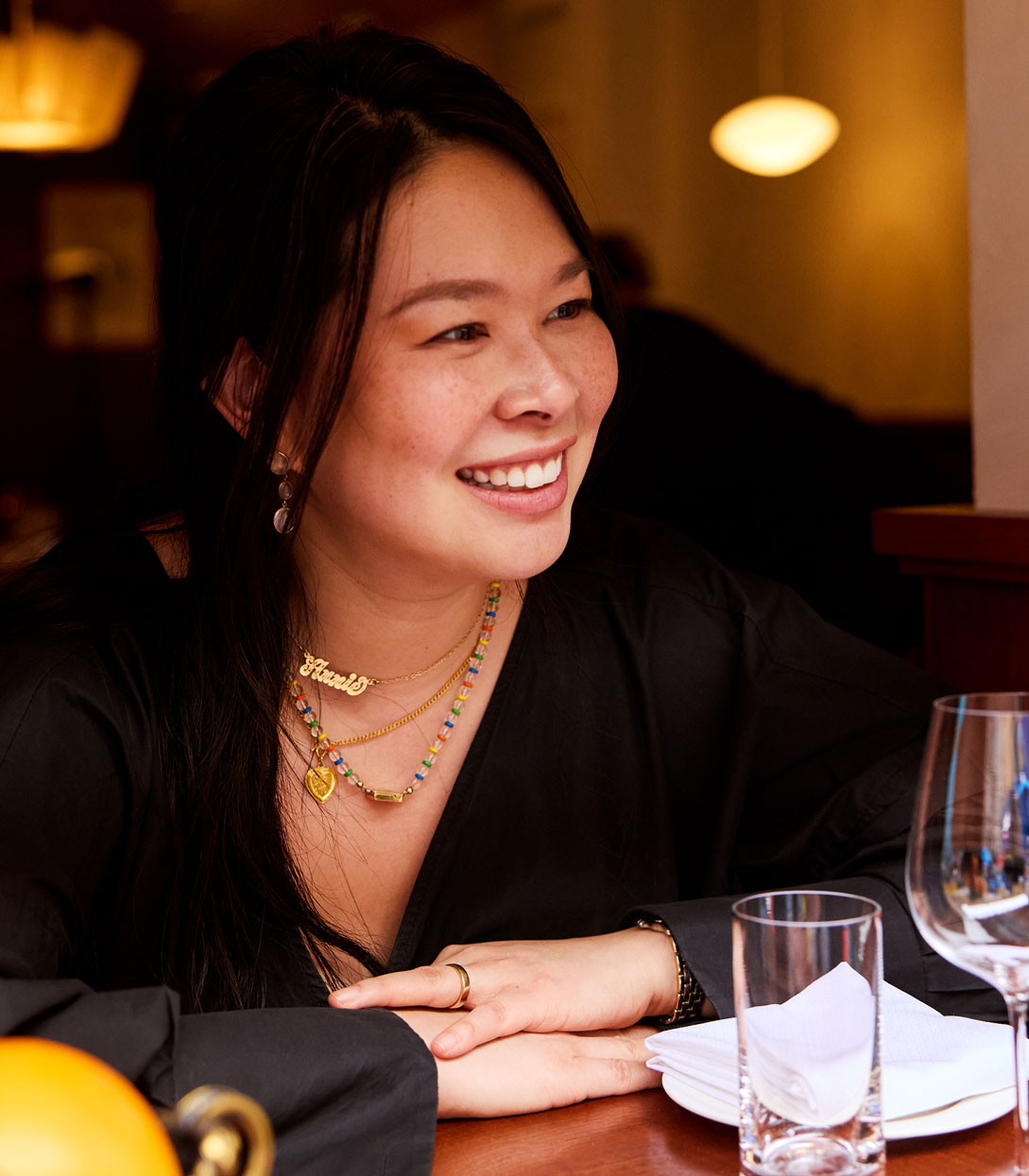The general American diner mindset has been programmed to expect sweet after savory when it comes to food—and the same goes for wine. Sweet wines like Moscato d'Asti, Riesling, Tokaji or Sauternes are almost always presented on a wine list at the end of the menu under headings such as "dessert wines" or "after dinner drinks."
In other countries, it is actually common to start the meal with a sweet wine such as the classic Portuguese apéritif of Port and tonic. In France, many begin with a chilled Tawny Port. However, sweetness is stigmatized in America, which might explain the lack of recognition of sweet wines in the United States.
"Any form of sweetness is viewed as unfashionable, and the general population of wine drinkers looks down at sweet wines as unsophisticated," says Master Sommelier Jim Rollston, wine director at three-MICHELIN-starred Manresa in Los Gatos, California.
Zwann Grays, the wine director of Bib Gourmand-designated Olmsted in Brooklyn, New York, agrees: "America has been scared straight when it comes to sugar. I struggle to sell a Riesling because guests insist it’s going to be sweet when what I’m suggesting actually has zero residual sugar in it. And yet, there’s a busy ice cream shop on every corner. We like sweet, but in wine it became taboo somewhere along the way."
What is Sweet Wine?
Sweet wines are, of course, quite sweet and can be made from a number of different methods. The most simple are those made from a fungus called Botrytis, also known as "noble rot," that dehydrates grapes, thus intensifying the sweetness levels and flavor. The most famous noble rot grapes are found in Bordeaux in the Sauternes region. Other types of sweet wines include ice wines, late-harvest wines and passito or dried/raisin wines, and can be found all over the world.
Sweet wines have varying levels of sweetness ranging from as low as 25 g/l of residual sugar (RS) in an off-dry Kabinett Riesling to over 450 g/l RS in a Tokaji Eszencia, explains Jeremy Shanker, lead sommelier at San Francisco’s MICHELIN-starred Michael Mina.
When it comes to enjoying a meal, all food and wine pairings are about balance. "A little bit of sweet makes salty food taste better. Sweet makes sour and spicy taste better too. Now come back to drinking a sweet wine with a dish that has any one of those flavors—especially in some sense of extremity—[and] a sip of something sweet could really bring balance to the entire tasting experience and get you to experience familiar flavors in an entirely new way," says Sarah Thomas, sommelier at three-MICHELIN-starred Le Bernardin.
With that in mind, let's take a step back from all the norms of sweet wines and see how top sommeliers across the country match them with your favorite savory foods.
Vegetarian and Spicy Foods
Sweetness in wine can have a great effect in balancing aspects of a dish, especially spicy heat. Riesling is hands down the top selection for spice. "Nothing cools down fiery cuisine such as Thai like a Riesling with a decent amount of residual sugar," says Advanced Sommelier Ryan Stetins of Compline in Napa.
Scott Baker, sommelier at the two-MICHELIN-starred Somni in Los Angeles agrees: "For spicy vegetable dishes, such as curries, I’d recommend a richer Riesling with some autumn fruit flavors such as apple, pear or quince and a suggestion of caramel—one I love is Memorista from Ovum in Oregon."
"I live in Los Angeles, and I eat my fair share of Korean, Japanese and Thai cuisine. A Riesling with some residual sugar goes a lot farther than a bottle of Cabernet Sauvignon from the Napa Valley," says Jordon Sipperley, beverage director at MICHELIN-starred Dialogue in Santa Monica.
Mushroom dishes also take particularly well to sweet wines: "They highlight the smoky nature of Botrytis, which is also a fungus after all," Shanker says.
Cooked or Grilled Seafood
"When I think seafood on the grill, my mind immediately turns to shrimp on the barbecue with a sweet citrus glaze," says Mark Guillaudeu, beverage director at two-MICHELIN-starred Commis in Oakland, California.
Here he leans towards the Italian fresh-and-fruity passito styles: Everything from delicate Erbaluce di Caluso passito down to Moscato di Noto in Sicily. The muscat-based wines especially shine with sweet orange-glazed dishes.
For grilled shellfish like lobster, sommelier Emilia Aiello of Lupa Osteria Romana in New York City turns to Sauternes from Bordeaux. "Fruit is oddly a nice compliment to shellfish and you will find the combination in many Asian cuisines. The peachy pineapple and sometimes lemony tones of Sauternes make an unlikely delicious pairing to lobster, which is a sweet meat. The smoky flavor imparted by the grill is a nice compliment to the honey and nutty notes of the wine. Try Château Lafaurie-Peyraguey, Sauternes, 1er Cru Classé."
Ceviche or Raw Seafood Dishes
Off-dry Riesling is a perfect pairing here for Shanker. Since many of these dishes (ceviche especially), have a spicy capsaicin component, a sweet wine like an off-day Riesling keeps it in check with the low alcohol level and slight presence of sweetness.
"In addition to this, German Rieslings have some of the highest acid levels of any sweet wines, and this acid is important in order to stand up to the lemon or lime component. A lower acid wine by comparison would seem 'flabby' in the presence of a dish with such high acidity," Shanker says.
Poultry
Poultry is essentially a blank canvas that could pair nicely with almost anything.
"You often see duck prepared with sweet, rich fruits in the accompanying sauce. Rather than putting those components in the dish itself, there’s no reason you couldn’t mimic that same effect with a rich, raisin-y Pedro Ximenez. I like Fernando Castillo’s PX," Thomas says.
Another great match would be Sauternes: "The caramelized smoky nature of the aged Sauternes harmonizes beautifully with the scored, crispy-skinned seared duck breast. The wine's richness matches the powerful, fatty texture of the duck," Shanker adds.
For Marissa Payne, lead sommelier at Cotogna in San Francisco, one of her favorite sweet wine pairings is actually with fried chicken. "You get that savory, salty and crispy quality and balance it out with something sweet. Like chicken and waffles or M&Ms and peanuts. Salty and sweet go hand-in-hand," Payne says. "If I am doing [an] Italian [sweet wine], the 2007 Felsina Vin Santo from Tuscany is my favorite pairing [with fried chicken]. If I am doing French, Château Climens, Sauternes 2015 from Bordeaux."
A juicy roasted chicken could lend itself to Macvin, according to Grays. This style of wine gives a bit of caramelized nuttiness. "Jean Francois Ganevat Macvin is clean enough for poultry but also has an earthy depth to rival [roasted] chicken," Grays says. Payne also recommends a Prà, "Bianco della Fontana," Passito from the region of Soave, Italy.
Red Meat
It is widely known that ruby Port is delicious with charcuterie. But for Thomas, her favorite is an off-dry Lambrusco with cured meats. "The light sweetness makes you keep reaching for the salty charcuterie (not that I typically need much prompting) and the bubbles help lift the palate from all the delicious fat and salt."
Our sommeliers also agreed that Madeira was up to the challenge to counter most red meats, raw, cooked or cured. "Madeira will add depth to red meat, which is already a substantial protein. If the meat is salted and seasoned enough, Madeira will wash that all down like a champ," Grays says.
A late harvest Malbec from Argentina is also great with red meats in general if you are shy about Madeira. Payne offers Susana Balbo Late Harvest Malbec for the tannin and body of a hearty red wine, but vinified to be low in alcohol so it doesn’t overwhelm the meat.
Cheese
Sweet wine and cheese go together . . . like sweet wine and cheese. Sauternes is a natural choice. Payne suggests an accessible bottle like Château Guiraud Sauternes, with notes of dried fruit, honeysuckle and a touch of smokiness. However, wine and cheese pairings can get quite particular, so ask your sommelier or beverage director what they recommend—and have fun with it.
Bottom Line
In general, Shanker advises diners to seek out wines that are always sweeter and higher in acid than the dish and match like flavors with one another. So even though it sounds good, "if you’ve ever drank a dry Champagne with dessert, you’ve probably regretted it."




















